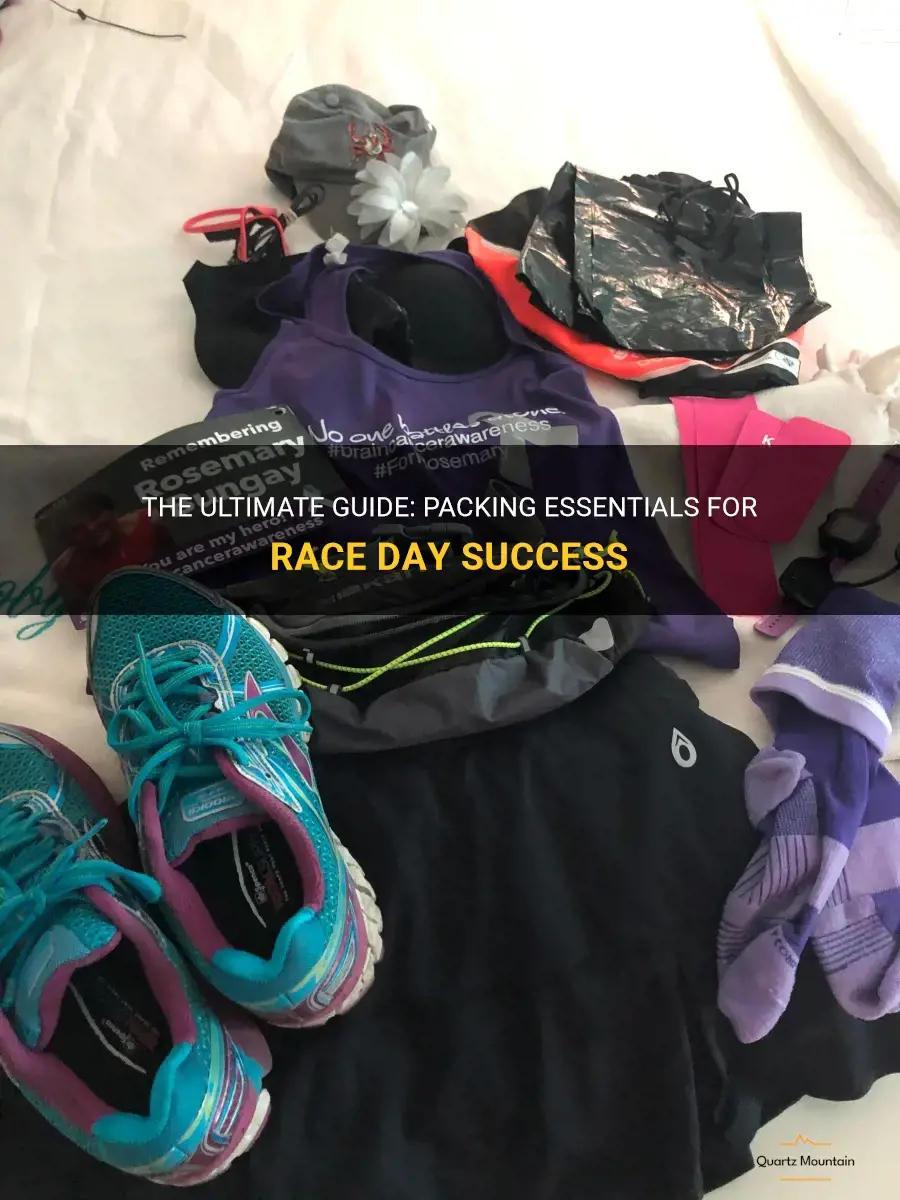
Race day is an exciting and nerve-wracking experience for any athlete. Whether you're getting ready for a marathon, triathlon, or a local 5k, being prepared is key to achieving success. That's why we've compiled the ultimate guide to packing essentials for race day. From gear and nutrition to comfort and recovery, we'll cover everything you need to ensure a smooth and enjoyable event. So grab your checklist and let's dive in, because with the right gear and preparation, you'll be crossing that finish line in no time.
What You'll Learn
- What are the essential items to pack for race day?
- Are there any specific clothing items or gear that should be included in a race day pack?
- Is it necessary to pack food and drinks for race day If so, what are some good options?
- Should I bring any personal care items or first aid supplies?
- Are there any extra items or tools that are commonly overlooked when packing for race day?

What are the essential items to pack for race day?
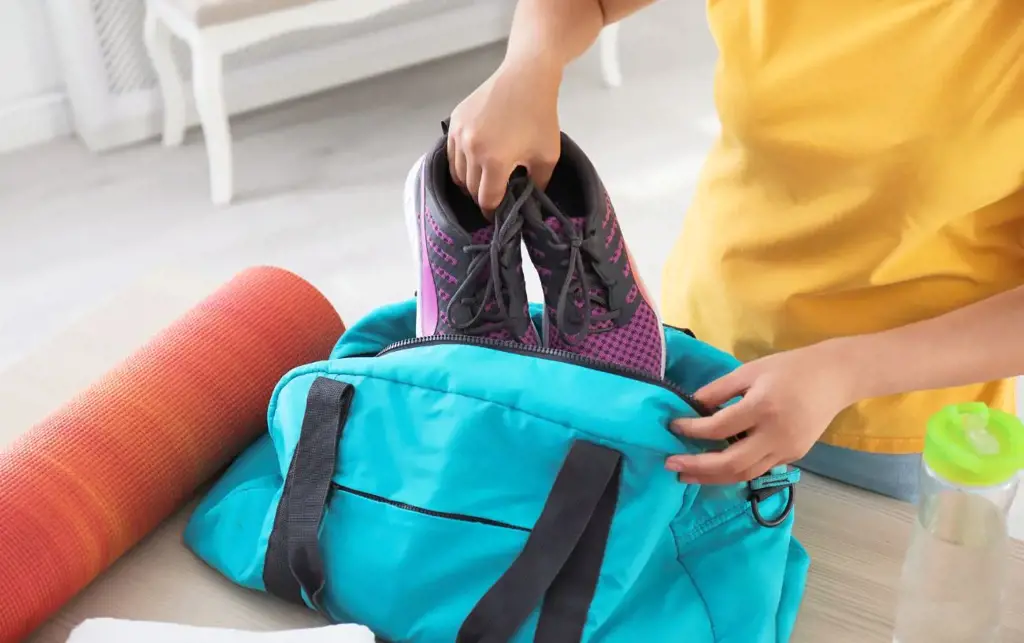
Preparing for a race can be an exciting yet nerve-wracking experience. As you gear up for the big day, it's important to pack all the essential items to ensure you have a smooth and successful race. Whether you're a seasoned runner or a first-timer, here are some must-have items to consider packing for race day.
- Running shoes: Your choice of running shoes can make or break your race day experience. It's crucial to wear a pair of well-fitting shoes that provide adequate support and cushioning. Make sure you break them in prior to race day to avoid any discomfort or blisters.
- Moisture-wicking clothing: Opt for lightweight, moisture-wicking clothing that allows for proper ventilation. This will help keep you cool and dry throughout the race, preventing chafing and discomfort. Don't forget to pack an extra set of clothing in case of unexpected weather changes or accidents.
- Race bib and safety pins: Your race bib is your identification and timing device. It's essential to attach it securely to your clothing using safety pins. Double-check that your race bib is properly assigned to you and displays all the necessary information.
- Hydration system: Staying hydrated during a race is crucial for optimal performance. Consider carrying a handheld water bottle, a hydration belt, or a hydration backpack, depending on your preferences. Make sure to test your chosen hydration system during training runs to ensure it's comfortable and doesn't cause any distractions.
- Energy gels or snacks: Longer races may require additional fueling along the way. Energy gels or snacks can provide a quick source of carbohydrates to help replenish your energy levels. Experiment with different options during your training runs to find what works best for you and pack extra for race day.
- Sunscreen and hat: Protecting your skin from the sun's harmful rays is essential, especially during outdoor races. Apply a high SPF sunscreen before the race and consider wearing a hat or visor to shield your face from direct sunlight. A sunburn can not only be uncomfortable but also affect your performance.
- Body glide or anti-chafing cream: Prevent discomfort and blisters by applying body glide or anti-chafing cream to areas prone to friction, such as underarms, thighs, and nipples. This will help reduce irritation and allow for a more pleasant race experience.
- Timing device: If you're concerned about tracking your pace and time during the race, consider wearing a GPS watch or using a running app on your smartphone. These devices can provide valuable data on your performance and help you stay on track with your goals.
- Extra safety pins and cash: It's always a good idea to carry some extra safety pins in case you lose or break yours. Additionally, having some cash on hand can be useful for emergencies or unexpected situations that may arise on race day.
- Positive mindset and determination: While not a physical item, a positive mindset and determination are crucial for a successful race day. Remind yourself of all the hard work and training you've put in and believe in your abilities. Stay focused, motivated, and enjoy the experience!
In conclusion, packing the right items for race day can greatly enhance your overall experience. Prioritize comfort, safety, and performance when selecting your gear and remember to test everything during your training runs. Pack these essential items, and you'll be well-prepared to tackle any race day challenges that come your way. Good luck!
Essential Items to Pack for a Successful Semester at Penn State Behrend
You may want to see also

Are there any specific clothing items or gear that should be included in a race day pack?
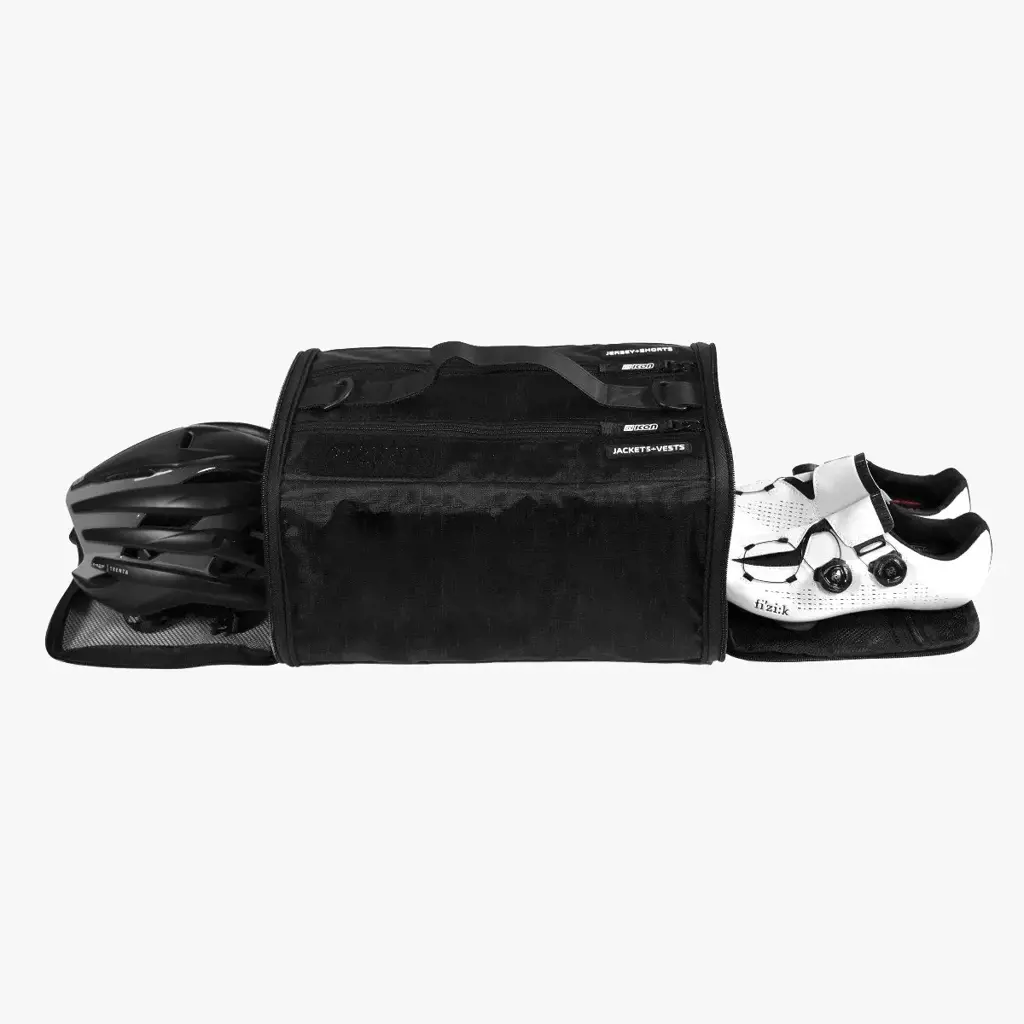
When it comes to participating in a race, having the right clothing and gear is crucial. These items can make a big difference in terms of performance and comfort. Whether you're running a marathon or participating in a triathlon, here are some clothing items and gear that should be included in your race day pack.
- Running shoes: Investing in a good pair of running shoes is essential for any race. Make sure to pick a pair that fits well and provides adequate support and cushioning for your feet. It's important to break in your shoes before race day to avoid any discomfort or blisters.
- Moisture-wicking clothing: Opt for clothing made from moisture-wicking materials such as polyester or nylon. These fabrics are designed to move sweat away from your body and keep you dry and comfortable during the race. Avoid cotton clothing, as it tends to trap moisture and can lead to chafing or discomfort.
- Compression gear: Compression gear such as shorts or sleeves can provide additional support to your muscles and improve circulation. They can also help reduce muscle fatigue and soreness during the race. If you've trained with compression gear and found it beneficial, it's worth including in your race day pack.
- Sunglasses: Protect your eyes from the sun's glare and potential debris by wearing a pair of sunglasses. Look for sunglasses that offer UV protection and have a comfortable fit, so they don't slide down your nose while running.
- Hat or visor: A hat or visor can provide shade and protect your face and eyes from the sun during a race. It can also help keep sweat out of your eyes, allowing you to maintain better focus and visibility.
- Performance socks: Investing in a good pair of moisture-wicking socks can help prevent blisters and keep your feet comfortable throughout the race. Look for socks that are made from synthetic fibers to keep your feet dry and reduce friction.
- Race belt or bib holder: If you're participating in a race that requires a bib, consider using a race belt or bib holder. These accessories allow you to securely attach your bib to your waist or body, without the need for safety pins. This can save time and prevent any annoyance or discomfort caused by a bouncing bib.
- GPS watch or fitness tracker: Monitoring your pace, distance, and heart rate during a race can be incredibly useful for tracking your performance and staying within your target goals. Consider wearing a GPS watch or fitness tracker to keep tabs on your progress and ensure you're on track.
- Water bottle or hydration pack: Staying hydrated during a race is crucial for maintaining performance and preventing dehydration. Depending on the race's distance and available water stations, consider carrying a water bottle or using a hydration pack to ensure you have access to fluids throughout the event.
- Personalized race nutrition: Fueling properly during a race can help maintain energy levels and prevent hitting the infamous "wall." Carry any gels, energy bars, or other nutrition products that you've used during training and found effective. It's essential to test these products during your training runs to ensure they don't cause any digestive issues.
When preparing your race day pack, it's important to consider the specific conditions, distance, and requirements of the race. It's also a good idea to do a test run with your gear to ensure everything fits comfortably and functions as expected. By having the right clothing and gear in your race day pack, you'll be setting yourself up for success.
Your Ultimate Hospital Bag Checklist for a Smooth Birth Experience
You may want to see also

Is it necessary to pack food and drinks for race day? If so, what are some good options?

Race day is an exciting and demanding time for athletes. Whether you are participating in a marathon, a triathlon, or any other endurance event, it is crucial to fuel your body properly before, during, and after the race. Packing food and drinks for race day can be essential to ensure that you have the energy and hydration necessary to perform at your best.
During a race, your body undergoes significant physical exertion. It is estimated that runners burn between 100 and 150 calories per mile, depending on factors such as weight, pace, and terrain. This means that during a marathon, you may burn over 2,600 calories! To keep your energy levels up, it is important to consume a mix of carbohydrates, proteins, and healthy fats before, during, and after the race.
Before the race, it is recommended to eat a balanced meal consisting of complex carbohydrates, such as whole grains or fruits, and lean proteins, like chicken or fish. This will provide your muscles with the necessary glycogen stores for endurance. It is also important to hydrate well before the race, consuming fluids like water or electrolyte drinks.
During the race, you will need easily digestible carbohydrates to sustain your energy levels. Pack small and portable snacks that are high in carbohydrates, such as energy gels, chews, or bars. These snacks provide a quick source of energy and are easily digested during exercise. Additionally, hydrating during the race is essential to prevent dehydration and maintain electrolyte balance. Consider carrying a handheld water bottle or investing in a hydration belt or pack to have a convenient way to drink fluids.
After the race, it is important to replenish your energy stores and aid in muscle recovery. Consuming a meal or snack containing a mix of carbohydrates and protein within 30 to 60 minutes after the race is crucial. This can be a protein shake, a turkey sandwich, or a bowl of oatmeal with fruits and nuts. Eating this combination of nutrients helps to repair muscle damage, restore glycogen stores, and promote overall recovery.
When selecting foods and drinks for race day, it is important to consider personal preferences, dietary restrictions, and tolerance to different types of foods. Some popular options for race day fuel include bananas, energy gels, sports drinks, granola bars, nut butter packs, and electrolyte-enhanced water. These options provide a mix of carbohydrates, proteins, and electrolytes to sustain energy levels and promote hydration.
In conclusion, packing food and drinks for race day is necessary to fuel your body and optimize performance. Consuming a balanced meal before the race, as well as portable snacks and hydration during the race, will provide the necessary nutrients and energy to keep you going. After the race, replenishing your energy stores with a mix of carbohydrates and protein will aid in recovery. With careful consideration of personal preferences and dietary needs, you can select the best options to support your race day performance.
Essential Items to Pack for a Memorable Stay at Amangiri
You may want to see also

Should I bring any personal care items or first aid supplies?
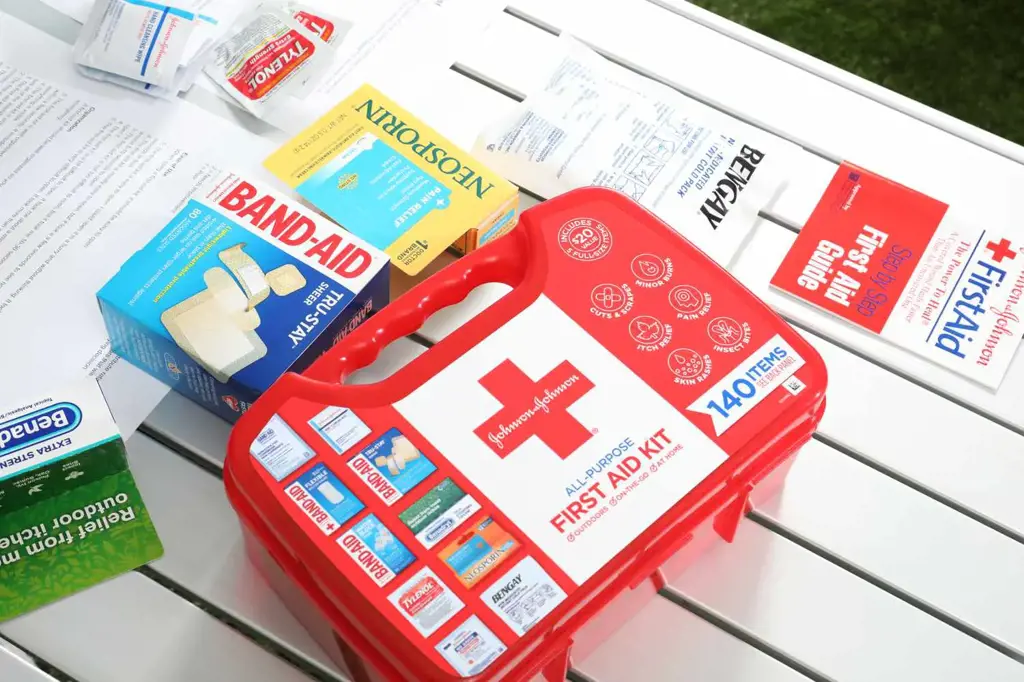
Whether you are going on a short trip or a longer journey, it is always a good idea to be prepared and bring along some personal care items and first aid supplies. These essentials can come in handy in various situations and help ensure your health and well-being while away from home. In this article, we will discuss the importance of bringing personal care items and first aid supplies when traveling and provide a list of essential items you should consider including in your travel kit.
Personal care items and first aid supplies are crucial for maintaining good hygiene and addressing minor health concerns while traveling. Here are a few reasons why you should include these items in your travel preparations:
- Basic hygiene: Personal care items such as toothbrush, toothpaste, soap, shampoo, and deodorant are essential for maintaining personal hygiene wherever you go. These items will help you stay fresh and clean throughout your trip, especially if you are traveling to places with limited access to clean water and sanitation facilities.
- Protection against illnesses: Traveling often exposes you to various germs and bacteria, especially when using public transportation or staying in crowded areas. Carrying hand sanitizer, sanitizing wipes, and face masks can help protect you from germs and reduce the risk of contracting common illnesses such as cold and flu.
- Emergency situations: While we hope to never encounter any emergencies during our travels, it is always wise to be prepared. Having a basic first aid kit can be a lifesaver in case of minor injuries, allergies, or any other medical issues that may arise. It allows you to address the situation promptly and seek professional medical help if needed.
Now that we understand the importance of personal care items and first aid supplies, let's discuss some essentials that you should consider packing when preparing for your trip:
- Medications: If you have any chronic conditions or require regular medications, make sure to pack enough for the duration of your trip. It is also a good idea to carry a copy of your prescriptions or a doctor's note, especially for controlled substances.
- Band-Aids and sterile gauze: These items are handy for treating minor cuts, blisters, and abrasions. Make sure you have a variety of sizes to cater to different types of wounds.
- Antiseptic solution: An antiseptic solution helps disinfect wounds and prevent infection. You can choose from options like hydrogen peroxide or povidone-iodine, whichever you find more convenient to carry.
- Pain relievers: Over-the-counter pain relievers such as acetaminophen or ibuprofen can help alleviate headaches, muscle pains, or fever, providing temporary relief until you can seek professional medical advice if necessary.
- Allergy medication: If you have known allergies or are traveling to an unfamiliar environment, consider carrying antihistamines to alleviate allergic reactions such as rashes, itching, or difficulty breathing.
- Sunscreen: Protect your skin from harmful UV rays by packing sunscreen with a high SPF rating. Apply it generously before heading outdoors, and reapply as needed throughout the day.
- Insect repellent: Depending on your destination, insects like mosquitoes or ticks can be a nuisance and carry diseases. Packing an insect repellent can protect you from insect bites and the potential illnesses associated with them.
- Personal care items: Bring travel-sized bottles of your preferred shampoo, conditioner, body wash, and other personal care products. You can transfer them to smaller, travel-friendly containers to save space in your luggage.
Remember, this list is not exhaustive, and you should tailor it to your specific needs and destination. If you have any pre-existing medical conditions or concerns, consult with your healthcare provider to determine what additional items you may require during your trip.
In conclusion, it is highly recommended to bring personal care items and first aid supplies when traveling. These essentials ensure good hygiene, protect against illnesses, and provide a sense of security in case of emergencies. By including items such as medications, band-aids, and sunscreen in your travel kit, you can be well-prepared to handle minor health issues and enjoy your trip with peace of mind.
Essential Items for a Solo Trip to Las Vegas: Your Ultimate Packing Guide
You may want to see also

Are there any extra items or tools that are commonly overlooked when packing for race day?
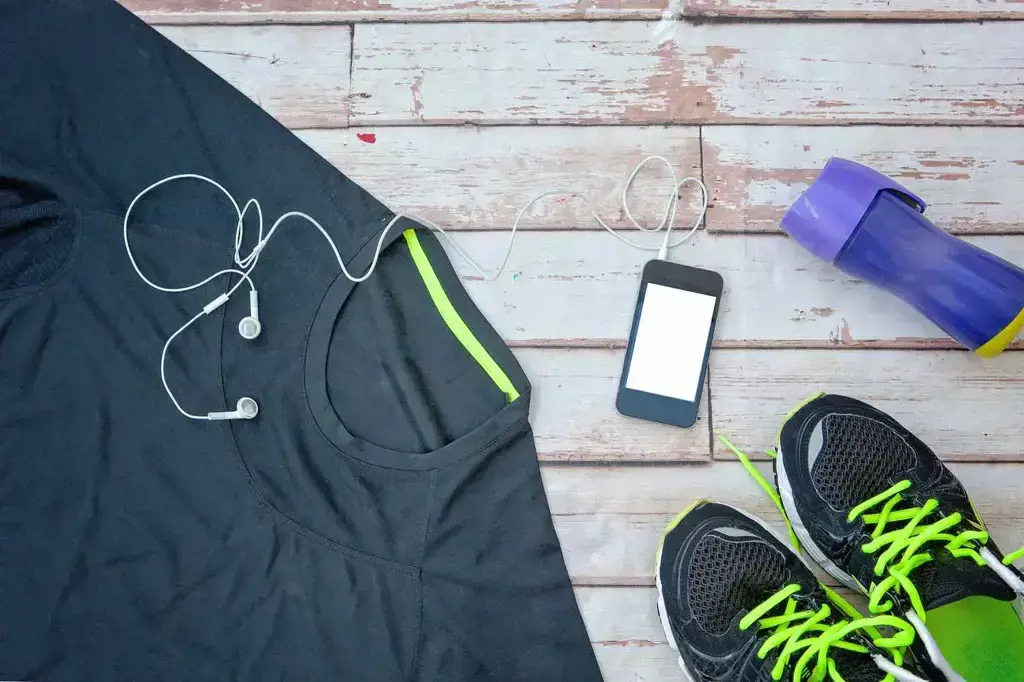
When preparing for race day, it is essential to have all the necessary items and tools to ensure a smooth and successful experience. While most runners remember to pack essentials such as running shoes, clothing, and hydration, there are a few commonly overlooked items that can make a big difference on race day. In this article, we will discuss some of these often-forgotten items and tools that can greatly enhance your race day experience.
One commonly overlooked item is sunscreen. Many runners forget to pack sunscreen, especially if the race is early in the morning or on a cloudy day. However, even on overcast days, the sun's harmful UV rays can still penetrate the clouds and cause sunburn. Applying sunscreen before the race can protect your skin from sun damage and prevent painful burns. It is recommended to choose a sweat-resistant sunscreen with a high SPF to ensure maximum protection throughout the race.
Another commonly overlooked item is a hat or visor. Wearing a hat or visor can provide much-needed shade and protect your face and eyes from the sun. This is especially important for races that take place during the summer months or in hot climates. A hat or visor can help keep you cool and prevent overheating, allowing you to maintain your performance throughout the race.
Additionally, many runners overlook the importance of carrying a small first aid kit or band-aids. While race organizers typically provide medical support along the course, it is always a good idea to have some basic first aid supplies on hand. Blisters, minor cuts, or scrapes can occur during a race, and having band-aids and antiseptic wipes can help alleviate any discomfort and prevent infection.
A foam roller or massage ball is another commonly overlooked tool that can be beneficial on race day. These tools can be used for self-massage before and after the race to help loosen tight muscles, improve circulation, and alleviate any pre-race jitters. Using a foam roller or massage ball on your legs, glutes, and back can help reduce muscle soreness and increase flexibility, allowing you to perform at your best.
Finally, many runners forget to pack extra safety pins for attaching their race bibs. Race organizers usually provide safety pins, but it is always wise to have a few additional ones in case they get lost or break. It can be a hassle to try and find replacement pins on race day, so having extras readily available can save you time and stress.
In conclusion, there are several commonly overlooked items and tools that can greatly enhance your race day experience. Remember to pack sunscreen to protect your skin from the sun's harmful rays, wear a hat or visor to provide shade and prevent overheating, carry a small first aid kit for any minor injuries, use a foam roller or massage ball for self-massage and muscle relief, and pack extra safety pins for attaching your race bib. By ensuring you have all these essential items, you will be well-prepared for a successful and enjoyable race day.
Essential Items to Pack for Your Darjeeling Adventure
You may want to see also
Frequently asked questions
On race day, it's important to have the essentials to ensure a successful and enjoyable experience. Some must-have items include running shoes, comfortable running clothes, race bib, timing chip, water bottle, energy gels or snacks, and sunscreen.
While water stations are typically provided along the race course, it's always a good idea to bring your own hydration pack or water bottle. This way, you can stay hydrated at all times, regardless of the availability of water stations.
It is recommended to pack some nutritional snacks or energy gels to fuel your body during the race. Make sure to choose items that you have trained with before and that work well with your stomach. This will help you maintain energy levels and perform at your best throughout the race.
It's important to wear comfortable and moisture-wicking clothing on race day. Opt for a moisture-wicking shirt, shorts or leggings, and running socks. Layering is also important, especially if the weather is unpredictable. Bring a light jacket or long-sleeve shirt that you can easily remove if you get too warm during the race.
It's always a good idea to pack extra clothing for after the race. You may want to change out of your sweaty race clothes and into fresh and comfortable clothing. Consider packing a clean shirt, socks, and a pair of flip-flops or comfortable shoes for post-race recovery. Additionally, having a warm and dry hoodie or jacket is essential if the weather turns cold after the race.







